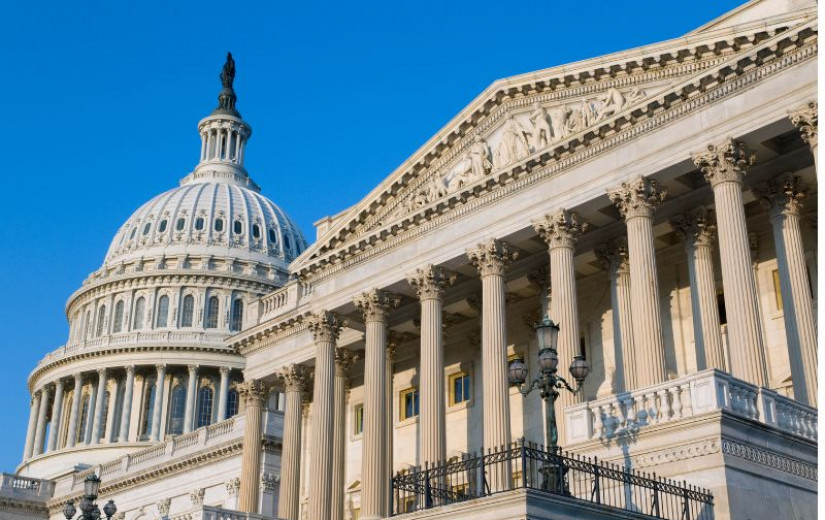President Trump’s so-called tariff “liberation day” brought significant financial fallout for the US, threatening the dollar’s supremacy and revealing deeper vulnerabilities in the US macroeconomic outlook. Fabio Sabatini writes that the threat to the dominance of the US dollar opens a window of opportunity for Europe.
With the Geneva agreement signed on 12 May, China joined the list of countries for which US tariffs have been scaled back to 10 per cent, following the financial turmoil triggered by “liberation day.” This levy comes on top of a 20 per cent tariff previously imposed as a punitive measure for China’s alleged role in the production of certain fentanyl components.
Yet the total still falls far short of the 80 per cent tariff Donald Trump had announced over the weekend. Markets reacted with relief: pressure on US Treasuries eased, and the dollar regained about one per cent against the euro.
Since “liberation day” on 2 April, Beijing has held firm, responding to each hike and ultimately maintaining its retaliatory 10 per cent tariff. The episode underscores how ineffective President Trump’s bargaining tactics have been in delivering positive outcomes for the United States.
Why Trump backtracked again
The consequences of Trump’s tariff war were felt immediately. In April alone, Chinese exports to the US plummeted by 21 per cent year-on-year. US manufacturers reliant on Chinese components began to slow production, raising concerns over potential job losses. Retail prices, meanwhile, have started to rise slowly but steadily. Research led by Alberto Cavallo shows that prices increased not only for Chinese imports but also for US-made goods.
The uncertainty clouding the US economy, along with the related contraction in consumption and investment, has sharply worsened employment expectations. The Federal Reserve acknowledged the deteriorating macroeconomic outlook by confirming a pause in its interest rate cuts: rates will remain at 4.25 per cent following three consecutive reductions implemented before the new president took office. While the labour market remains relatively stable, the Fed warned that Trump’s policies have heightened the risk of rising inflation coupled with higher unemployment, classic symptoms of stagflation.
Yet it was not just the macroeconomic picture that alarmed Trump’s economic advisers. The deeper reason for the shift in tariff policy—first on 9 April for the rest of the world, and now for China—was the financial chaos unleashed by “liberation day”: a flight from dollar-denominated assets and a sharp weakening of the dollar. After 2 April, US Treasury bonds experienced a wave of selloffs, pushing yields sharply higher.
American bonds are no longer held primarily by central banks, but by private investors whose decisions are driven not by strategic or institutional considerations, but by financial ones—namely, profit maximisation and risk perception. The political and economic instability triggered by the new administration has increased the perceived risk of US assets, making Treasuries far less attractive than they once were.
Dollar under threat
The surge in US Treasury yields is rooted in a deeper dynamic that Trump’s advisers have long overlooked. A country whose currency serves as the international reserve must, by definition, run persistent current account deficits to provide global liquidity. Trade-surplus countries reinvest their export earnings by purchasing safe US assets, such as Treasury bonds, thus facilitating the financing of US public spending. But this comes at the cost of a structurally overvalued dollar and a gradual erosion of the US manufacturing base.
However, the costs associated with the dollar’s role come with an extraordinary benefit: the privilege of borrowing without much concern over interest rates. Moreover, the decline in US manufacturing jobs—often presented in alarmist tones—is part of a broader structural transformation typical of advanced economies. The US has shifted toward services, where job creation has been more than triple the losses seen in manufacturing, and where the country consistently runs a trade surplus.
Traditionally, foreign investors and global safe-asset buyers have accepted lower returns in exchange for the security and liquidity of US government debt. Higher yields are associated with less creditworthy bond issuers. Even during global crises, the US usually issues vast amounts of debt without triggering a spike in yields.
After “liberation day,” that implicit discount, generally called “convenience yield”, seems to have vanished. For several days after 8 April, US Treasuries traded at higher yields than their equivalents. There even was a moment when 30-year Treasuries yielded more than their Greek counterparts, suggesting they were seen as riskier.
It was a clear sign that global demand for US debt is becoming more elastic and less enthusiastic. Historically, whenever Treasury yields rose, demand would quickly surge as investors rushed to combine higher returns with the exceptional liquidity of US bonds. But as shown in recent research led by Zhengyang Jiang and Hanno Lustig, when yields in US Treasuries increased faster than equivalent German Bunds recently, demand failed to pick up. On the contrary: the sell-off extended to other US assets, leading to a marked depreciation of the dollar against the euro, and providing evidence that the perception of Treasuries as the ultimate safe asset has been shaken.
These dynamics have led foreign investors to hold a substantial share of US public debt. According to the Federal Reserve’s Flow of Funds, in 2024 the Federal Reserve itself held $3.8 trillion in US Treasuries, while US households held $2.7 trillion and the rest of the world $8.5 trillion. China, in particular, holds a significant share of US sovereign bonds.
This ownership structure is not necessarily a problem. In fact, it is one of the clearest manifestations of the “privilege”: the world helping to finance America’s deficits. But if the dollar were no longer perceived as the “safe haven” it has long been taken to be, this structure could quickly turn into a vulnerability. What would happen if foreign investors—especially those from the US’s new “trade enemies”—began dumping American bonds en masse?
What worries White House economists most is not short-term market volatility or the worsened macroeconomic outlook, but the risk of fuelling a longer-term trend: a structural flight from US assets that could undermine a fundamental premise of the administration’s economic strategy. A large-scale reallocation of global savings away from the US and toward Europe could lead to a new monetary equilibrium in which global demand for dollars shrinks dramatically, challenging the American privilege of borrowing without much concern over interest rates.
If confidence in US assets continues to erode, the entire edifice of so-called “Maganomics” (already shaky and improvised) could collapse. Congress is preparing a new round of tax cuts, pushing the US debt-to-GDP ratio above 200 per cent. That’s already a dangerous setup for the future of Treasury markets. Financing these cuts with debt emissions would be extremely costly in the context of an asset flight from America.
What should Europe do?
Any shift in the international role of the dollar inevitably has repercussions for the euro. If Europe intends to capitalise on the US’s loss of credibility and promote the euro as a global reserve currency, it must be prepared to expand its sovereign debt market. In practice, this means offering assets perceived to be as safe and liquid as US Treasuries have been over the past 80 years and accepting the structural appreciation of the euro that would likely follow.
Europe has at least two compelling reasons to rise to this challenge. The first and more urgent is the need for resources to finance strategic autonomy from the United States. The second lies in the potential long-term benefits of transferring, even partially, the “exorbitant privilege” from the dollar to the euro: the ability to finance public spending without excessive concerns over yields, and the resulting boost to the financing capacity of the private sector.
Grasping this opportunity would require deep structural reforms and politically difficult choices. While monetary authority is centralised, fiscal authority still rests with individual member states, albeit within a framework of shared rules and coordination mechanisms. But the prize would be extraordinary: structurally greater fiscal capacity and the construction of a resilient global leadership, not only in monetary and financial terms, but above all in political influence and quality of life for European citizens.
Sign up for our weekly newsletter here.
- This blog post represents the views of its author(s), not the position of LSE Business Review or the London School of Economics and Political Science.
- Featured image provided by Shutterstock.
- When you leave a comment, you’re agreeing to our Comment Policy.









